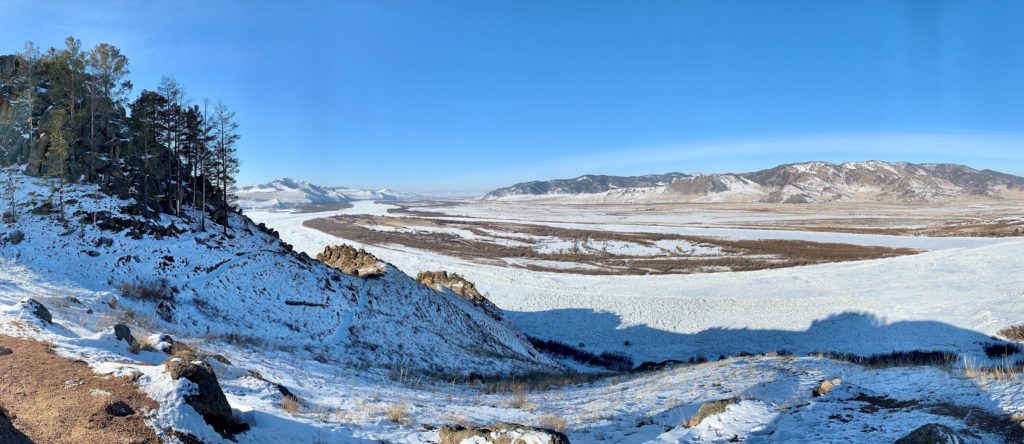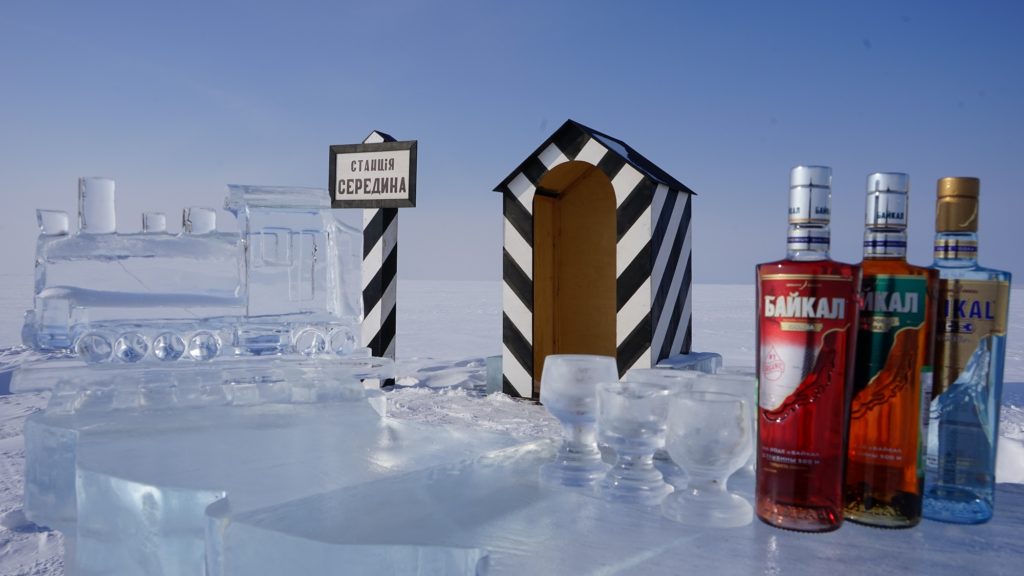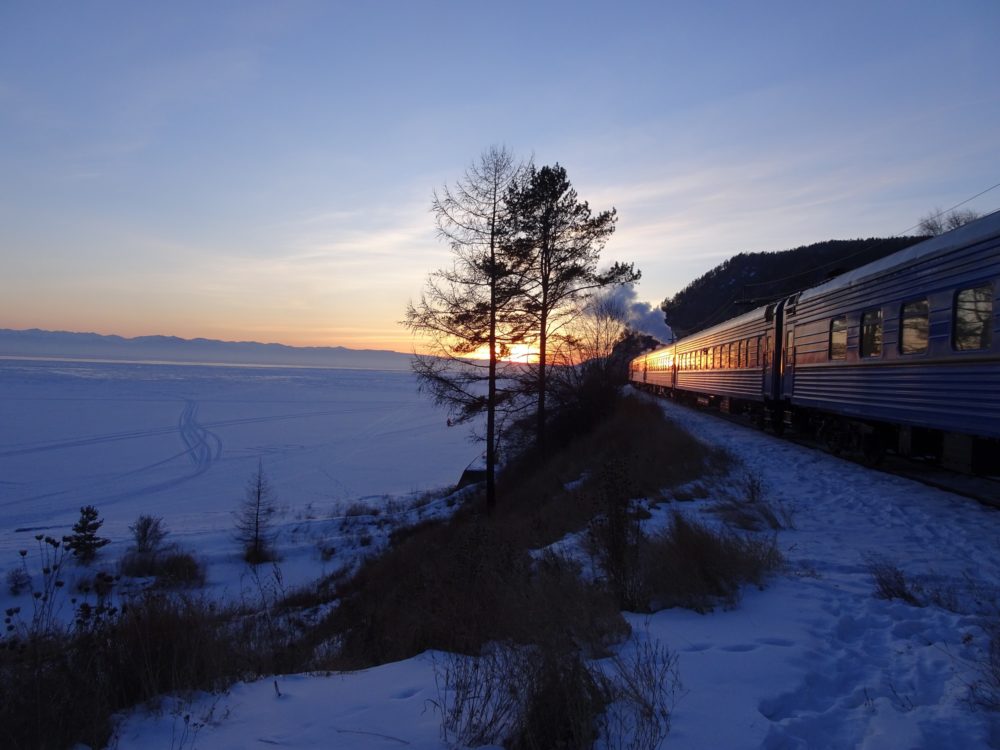Eskimos are famously said to have around 50 different words for snow; this is because it is such a crucial part of their lives. The linguist and anthropologist Franz Boas gave a number of examples. There is ‘aput’, snow on the ground; ‘qana’, snow falling from the sky; ‘piqsirpoq’, drifting snow; and so on. What about the Russians? If you take the Trans-Siberian Express in the winter, you will have no doubt that snow is a crucial part of their lives too, yet one word – ‘Sneg’ (снег) – suffices for everything. It is snowing: idyot sneg (идет снег). There’s snow on the ground: Sneg na zemle (Снег на земле). Snow is falling from the sky: s neba padaet sneg (с неба падает снег). Drifting snow: dreifuyushchii sneg (дрейфующий снег). Russians don’t need a plethora of words; snow is snow, and they just get on with it.
When I asked one of the Golden Eagle train managers, who hails from the Siberian city of Irkutsk, if people dreaded the coming of winter, she looked at me with mild surprise. Why would they? Snow is part of the cycle of their lives. In fact they enjoy it: they go cross country skiing, they go hiking with snow-shoes, they go dog-sledding – and they get to wear lovely fur coats. (PETA – People for the Ethical Treatment of Animals – hasn’t made it to Siberia, and would have little hope of converting people if it did!)
And Siberia is certainly at its most beautiful in the winter. I spent so much time staring out of the train windows at the fabulous landscape that all of the books I had brought with me sat unread on my cabin table.
Taking the Trans-Siberian in winter gives you a tremendous feel for what life is like for these people most of the year. Siberia constitutes 60% of the Russian territory and is way too large to have the same climate throughout, but even in the more temperate central area traversed by the Trans-Siberian Railway, summer only lasts three to four months. I am a veteran of summer Trans-Siberian trips; for five years I have been traveling with Golden Eagle as Guest Speaker. But I longed to see the ‘real’ Siberia – at least, as I remembered it from David Leans’ 1965 film of Pasternak’s novel, Dr. Zhivago! I wanted to ride in a troika (a sledge pulled by three horses). I wanted to see snow-covered birch trees race past the train windows. I wanted to see all those cities I was so familiar with, coated in a soft white blanket. Above all, I wanted to see the magnificent Lake Baikal frozen solid with blue transparent ice. Finally I got my chance in February 2019.

Fear of the cold puts many people off Golden Eagle’s Winter Wonderland trip, so the numbers are much smaller than on the summer Trans-Siberian tours. We had 22 clients on my trip; on the summer trips there can be as many as 90. While the large groups are fun, with so many new people to meet, a small group inevitably develops a much greater sense of intimacy. This was helped by the fact that the larger groups have two dining cars, while we winter Trans-Siberians had just one. Although people in the large groups are encouraged to use both dining cars, they generally eat in the car nearest their own cabins, and so to some extent the group splits into two. Conversely, those of us on the Winter trip ate all our meals together, and got to know each other really well. We also bonded over our complementary Golden Eagle clothing! We were supplied with a number of cold-weather essentials – furry Russian hats, thick woollen mittens, socks, scarves, and – best of all – the wonderfully warm Russian felt boots, valenki. My pair still have pride of place on my shoe rack at home, and I am looking forward to showing them off to my neighbours come the next English winter.
So what is travelling on the Trans-Siberian Express like in the winter, and how does it differ from the summer trip? Firstly, I should confess that the winter of 2018-19 was unusually mild. There had been a prolonged cold spell just before we arrived, when the temperature remained well below minus 30 Celsius for some 10 days, but this was now just a conversation topic. (‘You should have come a week ago! That was the real Siberian winter!’) Our morning temperatures were generally around minus 22; my fingers and face tingled, but rather pleasantly. By the mid-afternoon it was up to an almost balmy minus 9. We were able to stay outside for hours on excursions and be in no danger of frostbite, or even of discomfort. Golden Eagle manager Tatiana assured me that they have never had to cancel any parts of the programme; if people are adequately dressed, they are in no danger. But my group had all the beauty of a Siberian winter without much of the inconvenience. My one regret was that it was nowhere near cold enough for us to take selfies of our ice-encrusted eye-lashes and eyebrows – I thought I would have the ideal photo for my home-made Christmas cards! But the trip gave me plenty of other Christmas card possibilities.
There is something undeniably gorgeous about snow. Our city tours were for the most part the same as those on the summer trips, but while I know all of these Siberian cities really well by now, I felt I was seeing them as if for the first time, and as they should be seen – preening themselves under thick white robes. The guides cautioned us to be careful in case the pavements were slippery, but I didn’t find them so. I did have a hiking stick with me, and some of us had brought spikes, also available from hiking shops, which can be attached to the bottoms of boots. These proved really useful, and I would advise anyone thinking of doing a winter Trans-Siberian to bring them.

Two days of the trip were very different on the winter Trans-Siberian. One was the day spent on Lake Baikal. This is one of my favourite days on the summer tours. The train makes its first stop at a tiny station called Polovina, where the bravest souls swim in the lake. Even in mid-summer the water temperature is rarely more than 8 degrees, but is so refreshing and rejuvenating that you feel you have sliced 20 years off your age. The train is pulled by a steam engine around the southern shore of the lake, and does a drive-past, whistling and hooting, which provides the most wonderful photo opportunities. At the next stop, Port Baikal, the train is parked, and we go by ferry to Listvyanka, where, after visiting an excellent museum about the lake’s geography and geology, one of our options is a hike up Mount Chersky, where we have the most beautiful view of the lake, of Port Baikal, and of our train having its snooze. The day finishes with a final stop at a BBQ site overlooking the lake, where we get to sample a fish found nowhere else in the world, the omul. Could this day be any better?
In the winter, it arguably is. Of course there is no swimming or hiking, but what we did instead was absolute magic. From Listvyanka we went by hovercraft over the frozen lake, making a brief stop to watch someone fish through a hole he had carved in the ice, then carrying on through what seemed to be deep Siberian wilderness to find, in the middle of nowhere, the luxury we had come to expect from Golden Eagle: a table carved from ice, covered in ice glasses and bottles of ice-cold vodka, and bowls full of icy Siberian berries; ice sculptures, including a train – what else! – and an ice sledge; a wooden hut in which lunch was later served (which included the glorious omul fish); and best of all – and this really was straight out of Dr. Zhivago – two sledges drawn by teams of huskies who raced us across that blue transparent ice. And if that was not enough, there were also snowmobiles: we could either drive ourselves, or be driven by fur-clad Siberians who looked as if they had just walked off a Dr. Zhivago set. And we still had the steam train drive-past when we got back to Port Baikal. This was – as many of us enthusiastically declared at the time – one of the best days of our lives.
Another activity which marked the Winter Wonderland trip from the summer Trans-Siberian took place during the Irkutsk excursion. The city was fully explored in all its wintry glory, but we were also taken to a forest on the edge of town to take turns in a troika. This was another Dr. Zhivago moment, though with a twist: the horses were determined to be extra helpful. When the driver hopped off to fetch something, leaving our first four clients sitting in the troika and the horses calmly waiting for him, they suddenly got it into their heads to save time by setting off by themselves. The driver chased after them, but to no avail; they did their usual circuit of the forest, and pulled up happily at the right place at the end of their little tour.

The trip to Mongolia was also different, at least in one respect. On the summer trips we go to Mongolia in our Golden Eagle train; customs and passport control take place on the train while we are stopped at the border. In the morning we arrive in the capital, Ulaan Baatar, and after a full day’s touring we return to the train after dinner and set off back to Russia. On the Winter Trans-Siberian we went by chartered plane from Russia to Mongolia, and had a real treat – a night in the exquisite Shangri La hotel in Ulaan Baatar. The touring programme was much the same, and anyone concerned that the plane ride would mean they had not done the Trans-Siberian railway in full can rest assured. We returned to our train where we left it, in Ulaan Ude, and continued on the normal Trans-Siberian route.
Having sung the praises of the Winter Wonderland trip, does this mean that I would recommend it over the summer Trans-Siberian? This is not necessarily the case; they both have their merits. Summer in Siberia is a precious time, and locals are determined to enjoy it. One year it turned out that on each of the three tours I did, we arrived in Irkutsk on the weekend, and the main square, Ploshchad Kirova, was hosting a different festival each time. There were amateur folk groups performing Siberian songs; there were troupes of dancers; there was an exhibition by organic vegetable growers, some of whom had decorated their hats and dresses with vegetables and fruit; there was a children’s talent contest, in which one little girl took the microphone and read out her own poem about her beloved Irkutsk and the jewel in its crown, Baikal. In each of these festivals the sense of civic pride was palpable. I got the impression that winter was welcomed not only for the skiing and snow-shoeing and fine fur coats, but also because it gave people the chance to practice and hone the talents and skills they would show off in these summer festivals.
In short, Siberia is a magnificent place to visit in both summer and winter, and I feel extremely fortunate to have experienced it in both seasons. Winter does bring some inevitable inconveniences; even if it is relatively mild, you still do have to wear a lot of extra clothes, and putting them on and taking them off can be tedious. Surprisingly, however, the weather in the summer can be more irritating, because it sometimes rains – and sometimes heavily. While Golden Eagle provides huge umbrellas to keep us dry, rain is always a nuisance. And the same liquid which comes out of the sky in the summer takes the form of that beautiful Dr. Zhivago white stuff – sneg! – in the winter.
You can view all our journeys aboard the Golden Eagle, including the Trans-Siberian Express and Winter Wonderland tours, by clicking here.

 Search
Search





